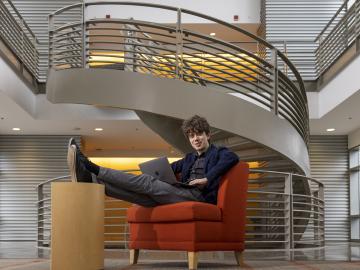
Filter News
Area of Research
- (-) Biology and Environment (44)
- (-) Materials (34)
- (-) Supercomputing (9)
- Advanced Manufacturing (1)
- Chemistry and Physics at Interfaces (1)
- Clean Energy (78)
- Data (1)
- Energy Frontier Research Centers (1)
- Functional Materials for Energy (1)
- Fusion and Fission (7)
- Isotope Development and Production (1)
- Isotopes (9)
- Materials Synthesis from Atoms to Systems (1)
- Materials Under Extremes (1)
- National Security (16)
- Neutron Science (8)
- Nuclear Science and Technology (5)
- Renewable Energy (1)
- Sensors and Controls (1)
News Type
News Topics
- Big Data (2)
- Bioenergy (11)
- Biology (17)
- Biomedical (4)
- Biotechnology (2)
- Chemical Sciences (5)
- Clean Water (4)
- Climate Change (8)
- Composites (1)
- Computer Science (5)
- Coronavirus (2)
- Decarbonization (4)
- Energy Storage (2)
- Environment (26)
- Exascale Computing (2)
- Frontier (1)
- Fusion (1)
- High-Performance Computing (8)
- Hydropower (2)
- Machine Learning (1)
- Materials (5)
- Materials Science (8)
- Mathematics (2)
- Mercury (3)
- Microscopy (7)
- Nanotechnology (4)
- Net Zero (1)
- Neutron Science (2)
- Nuclear Energy (2)
- Physics (7)
- Polymers (3)
- Quantum Computing (1)
- Simulation (4)
- Summit (1)
- Sustainable Energy (6)
Media Contacts

Carly Hansen, a water resources engineer at Oak Ridge National Laboratory, is rethinking what’s possible for hydropower in the United States.

Belinda Akpa is a chemical engineer with a talent for tackling big challenges and fostering inclusivity and diversity in the next generation of scientists.

Rich Giannone uses bioanalytical mass spectrometry to examine proteins, the primary driver in biological systems.

Cory Stuart of ORNL applies his expertise as a systems engineer to ensure the secure and timely transfer of millions of measurements of Earth’s atmosphere, fueling science around the world.

Marcel Demarteau is director of the Physics Division at the Department of Energy’s Oak Ridge National Laboratory. For topics from nuclear structure to astrophysics, he shapes ORNL’s physics research agenda.

Systems biologist Paul Abraham uses his fascination with proteins, the molecular machines of nature, to explore new ways to engineer more productive ecosystems and hardier bioenergy crops.

In the search to create materials that can withstand extreme radiation, Yanwen Zhang, a researcher at the Department of Energy’s Oak Ridge National Laboratory, says that materials scientists must think outside the box.

With the rise of the global pandemic, Omar Demerdash, a Liane B. Russell Distinguished Staff Fellow at ORNL since 2018, has become laser-focused on potential avenues to COVID-19 therapies.

In the Physics Division of the Department of Energy’s Oak Ridge National Laboratory, James (“Mitch”) Allmond conducts experiments and uses theoretical models to advance our understanding of the structure of atomic nuclei, which are made of various combinations of protons and neutrons (nucleons).

Joe Paddison, a Eugene P. Wigner Fellow at the Department of Energy’s Oak Ridge National Laboratory, believes there’s more information to be found in neutron scattering data than scientists like himself might expect.


